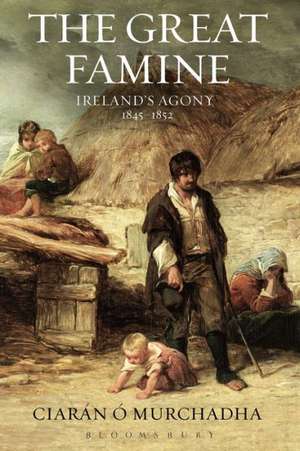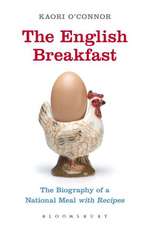The Great Famine: Ireland's Agony 1845-1852
Autor Dr Ciarán Ó Murchadhaen Limba Engleză Paperback – 8 mai 2013
Preț: 161.76 lei
Nou
Puncte Express: 243
Preț estimativ în valută:
30.96€ • 33.61$ • 26.00£
30.96€ • 33.61$ • 26.00£
Carte tipărită la comandă
Livrare economică 22 aprilie-06 mai
Preluare comenzi: 021 569.72.76
Specificații
ISBN-13: 9781472507785
ISBN-10: 1472507789
Pagini: 272
Ilustrații: 8
Dimensiuni: 156 x 234 x 23 mm
Greutate: 0.45 kg
Editura: Bloomsbury Publishing
Colecția Bloomsbury Academic
Locul publicării:London, United Kingdom
ISBN-10: 1472507789
Pagini: 272
Ilustrații: 8
Dimensiuni: 156 x 234 x 23 mm
Greutate: 0.45 kg
Editura: Bloomsbury Publishing
Colecția Bloomsbury Academic
Locul publicării:London, United Kingdom
Caracteristici
New paperback edition of an acclaimed, successful text shortlisted for the Longman-History Today prize
Notă biografică
Ciarán Ó Murchadha is a specialist in modern Irish history. His earlier Famine study, Sable Wings over the Land (1998), has been acclaimed as opening new ground in the study of the Great Famine.
Cuprins
PrefacePrologue1. An Emerging People: The Pre-Famine Irish2. A Long Farewell to the White Potatoes: The Coming of the Blight3. One Wide Waste of Putrefying Vegetation: The Second Failure of the Potato4. The Blessed Effects of Political Economy: Public Works and Soup Kitchens5. Emaciated Frames and Livid Countenances: From Fever Pandemic to Amended Poor Law6. Asylum by the Neighbouring Ditches: The Famine Clearances7. Leaving this Land of Plagues: The Famine Emigrations8. Exiled from Humanity: The Last Years of the Famine9. The Murdered Sleeping Silently: AftermathSource NotesNotesBibliographyIndex
Recenzii
[H]ighly readable...the author makes good use of the works of many travel writers who left us vivid descriptions of the poverty of ordinary Irish people.
Building on new research from the last 15 years, Ó Murchadha has created a fine overview of the famine...Dr Ó Murchadha's book is a welcome addition to famine historiography and it demonstrates that there is still much that remains to be told about this catastrophe.
Very readable and based on scholarly research, the book makes extensive use of the many local studies of recent years and provides harrowing eyewitness accounts of the catastrophe.
The prologue to The Great Famine encapsulates the book: microscopic detail is painstakingly assembled to propel a compelling narrative sweep ... [Ó Murchadha] integrates the prodigious Famine scholarship of the last twenty years, drawing extensively on accomplished local studies, to provide a comprehensive record of the Famine across the entire country ... Replete with startling contemporary images and almost unbearably vivid first-hand accounts, The Great Famine is a succinct, accessible and compassionate history - for scholars and the general reader - informed by an imaginative approach.
Ciaran O Murchadha has for many years been publishing original and valuable accounts of the Great Famine in Clare... He has now produced a wider study, which in addition to presenting the fruits of his own extensive research also incorporates and sunthesises the work of other scholars on this subject in recent years. The result is a most impressive and extremely valuable contribution to the historiography of this tragic era in Irish history.
Ó Murchadha paints a vivid portrait in words of the grim few years, supplemented by some equally harrowing pictures integrated with the text...Anybody wanting to understand some of the historical underlying resentment of the smaller nation towards the larger over the last two centuries could hardly do better than to start with this book.
The time is ripe for a fresh, synthetic history of the Great Irish Famine that builds on the many excellent local histories of the famine written in the 1980s and 1990s. Ciarán Ó Murchadha's lucid and moving account is exactly this: a work of great narrative and analytic power that is accessible, courageous, and ably written. It will be widely read, and deserves to be.
One of the tragedies of the famine is that so many of the dead remain invisible: their deaths were unrecorded and many of the dead were buried without coffin, headstone or traditional burial rites. In actually naming some of the victims of the famine - Dennis McKennedy who was owed over two weeks wages when he died; Jeremiah Hegarty, employed on the public works, who gave his meager supply of food to his grandchildren because they were 'crying with hunger' - Ó Murchadha gives to the famine dead a dignity and a recognition that has been denied to them for so long. This is a compelling read for both scholars of the Famine and those who are new to the topic. It is beautifully written, rich in detail and interspersed with contemporary images that enhance the text.
Ciarán Ó Murchadha has written an extraordinary book about the Great Famine that is full of fresh and penetrating insights into the causes of the catastrophe, the complex unfolding of the crisis, its profound consequences, and the much-debated question of responsibility. In this sweeping, powerfully evocative, and always probing account, Ó Murchadha combines his own original research and thinking with an impressive command of the extensive work done by other scholars over the last two decades. His book deserves the widest possible audience.
Building on new research from the last 15 years, Ó Murchadha has created a fine overview of the famine...Dr Ó Murchadha's book is a welcome addition to famine historiography and it demonstrates that there is still much that remains to be told about this catastrophe.
Very readable and based on scholarly research, the book makes extensive use of the many local studies of recent years and provides harrowing eyewitness accounts of the catastrophe.
The prologue to The Great Famine encapsulates the book: microscopic detail is painstakingly assembled to propel a compelling narrative sweep ... [Ó Murchadha] integrates the prodigious Famine scholarship of the last twenty years, drawing extensively on accomplished local studies, to provide a comprehensive record of the Famine across the entire country ... Replete with startling contemporary images and almost unbearably vivid first-hand accounts, The Great Famine is a succinct, accessible and compassionate history - for scholars and the general reader - informed by an imaginative approach.
Ciaran O Murchadha has for many years been publishing original and valuable accounts of the Great Famine in Clare... He has now produced a wider study, which in addition to presenting the fruits of his own extensive research also incorporates and sunthesises the work of other scholars on this subject in recent years. The result is a most impressive and extremely valuable contribution to the historiography of this tragic era in Irish history.
Ó Murchadha paints a vivid portrait in words of the grim few years, supplemented by some equally harrowing pictures integrated with the text...Anybody wanting to understand some of the historical underlying resentment of the smaller nation towards the larger over the last two centuries could hardly do better than to start with this book.
The time is ripe for a fresh, synthetic history of the Great Irish Famine that builds on the many excellent local histories of the famine written in the 1980s and 1990s. Ciarán Ó Murchadha's lucid and moving account is exactly this: a work of great narrative and analytic power that is accessible, courageous, and ably written. It will be widely read, and deserves to be.
One of the tragedies of the famine is that so many of the dead remain invisible: their deaths were unrecorded and many of the dead were buried without coffin, headstone or traditional burial rites. In actually naming some of the victims of the famine - Dennis McKennedy who was owed over two weeks wages when he died; Jeremiah Hegarty, employed on the public works, who gave his meager supply of food to his grandchildren because they were 'crying with hunger' - Ó Murchadha gives to the famine dead a dignity and a recognition that has been denied to them for so long. This is a compelling read for both scholars of the Famine and those who are new to the topic. It is beautifully written, rich in detail and interspersed with contemporary images that enhance the text.
Ciarán Ó Murchadha has written an extraordinary book about the Great Famine that is full of fresh and penetrating insights into the causes of the catastrophe, the complex unfolding of the crisis, its profound consequences, and the much-debated question of responsibility. In this sweeping, powerfully evocative, and always probing account, Ó Murchadha combines his own original research and thinking with an impressive command of the extensive work done by other scholars over the last two decades. His book deserves the widest possible audience.












